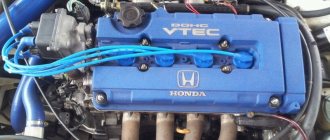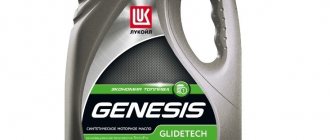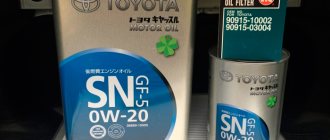VAZ is an engineering plant, the history of which has already crossed the fifty-year mark from the production of the first car. Over the many years of its activity, VAZ has undergone modernization several times, and this has helped it even today to compete adequately with foreign automakers. And if an old “kopek” or “six” can most often be found in small cities and towns, then cars of new years of production successfully compete with “foreign cars” on the roads of megacities.
Recommendations for choosing engine oil for VAZ.
The significant advantages of a domestic car are its affordable price range and maintainability, which allows you to easily service the car at home. The long service life of the cars is another huge plus for the automaker, and the wear resistance of the car is guaranteed by proper and timely care of the owner for his vehicle. In this article we will talk about one of the most important areas of car care - changing the oil in the power unit, namely, the correct choice of engine oil and the importance of this point for the functioning of vehicles. Let's consider what kind of oil to pour into a VAZ engine, how to choose the right lubricant for your car in order to ensure a long period of operation and be confident in the reliability and uninterrupted operation of the engine.
The main criteria for choosing a motor oil
Choosing the most suitable engine fluid is a difficult task not only for owners of domestically produced cars, but also for any consumer. The task is complicated by the huge range of lubricants on the market and their technological characteristics, which may be perfectly suitable for one model of machine and be strictly contraindicated for another.
When choosing oil for a VAZ, it is important to follow the instructions from the car manufacturer, taking into account the following criteria, which can significantly affect the choice:
- vehicle model, taking into account its year of manufacture and engine modification;
- wear and tear of the power unit, which is determined by the mileage traveled by the car, driving style and the degree of load on it;
- climatic operating conditions.
These factors, taking into account the manufacturer’s regulations, determine the final choice of motor fluid. Let's consider how to make the correct and rational selection of a lubricating emulsion for the engine of your vehicle.
Correct selection of lubricants
First of all, before making a selection, it is important to decide what type of lubricant is best for your car. Engine lubricants are provided to the consumer in three categories: synthetic, mineral and semi-synthetic.
It is generally accepted that synthetic oil is an example of quality that is suitable for any engine and will cope with its functional tasks as well as possible. And indeed this is almost always the case when it comes to modern engines of new modifications. In situations where a car oil is selected for a worn-out engine, or the manufacturer recommends the use of a mineral or semi-synthetic lubricant from the factory, synthetics may not only fail to fulfill their tasks, but also significantly affect the functionality and operational period of the power unit in the direction of worsening the criteria. Old VAZ models that came off the assembly line before 1990 are equipped with rubber sealing components that are exposed to synthetic ingredients and subject to deformation, which will negatively affect the performance of the engine.
For new vehicle models, synthetics are indeed recommended, however, again, you should be guided solely by the regulations. If the manufacturer advises using only semi-synthetic lubricant for a specific car model, then purchasing synthetics in this case will simply be throwing money away. In addition, according to the advice of professionals, switching to mineral lubricants will be justified if the car has a mileage of more than two hundred thousand kilometers. When selecting a car oil, you should additionally focus on the price criteria of the lubricant: the engine of even old Zhiguli cars will react negatively to low-quality cheap lubricant. Preference should be given to oils of the middle category in terms of price. In the user manual, the manufacturer always indicates the recommended engine oil quality standards, as well as the names of motor oils that are approved for use in a specific car model.
And then the most interesting thing: to understand the markings and not everyone understands the specifications that are indicated on the labels of the products offered, and for owners of old cars to also choose an alternative option from the modern assortment, taking into account the technological data of lubricants, since if the car is out of production, find a “original” » lubricating the motor is almost impossible.
Do I need to look for a special oil for VAZ engines?
There is nothing supernatural, as you yourself understand, in these engines. Now I’m silent about VAZ models, a la: 2110, 2106, 2107, 2112, 2114... Well, what are you talking about? Well, the maximum that can be offered for them is motor oils with viscosities according to SAE 5w40, in principle, from any manufacturer (naturally, not a garage one). Why is this particular thickness recommended? It's simple!
As practice has shown, it is possible to fill in both mineral and semi-synthetic. However, synthetics always provide additional guarantees that it:
- Minimal loss of fluidity in severe frosts
- It will be more successful to counteract the high temperature during engine operation.
- Most often has a low-ash base
Our answer: it is enough to find normal semi-synthetics (both domestic and imported ones will do). It makes sense to make a replacement in the area from 7 to 9 thousand km. (especially if you use gas as fuel).
Marking features
In searching for an answer to the question of which oil is best to pour into the engine, you need to learn how to navigate the standardization of motor oils according to the SAE viscosity coefficient and API class. Cars from domestic automakers are no exception in this regard. For convenience, we will divide VAZ vehicles into two categories: those produced before and after 2000.
The first category of cars, produced before 2000, is mainly models from “kopek” to “seven”, as well as the VAZ-2121 family of cars, modified with carburetor-type units. Motor oils for these machines must comply with the API product category marked SF, which regulates their intended use for engines running on gasoline with a low ethyl ratio and operating under severe operating conditions. These are mainly mineral-based lubricants, which have proven themselves when used in engines with significant wear. SF class motor oils are distinguished by high anti-wear and anti-corrosion properties, protect the unit from deposits without corroding structural sealing parts.
The second group of VAZ cars are cars that came off the assembly line after 2000, including the new Vesta and XRAY models from VAZ. The power units of these vehicles, regardless of the year of production, require a lubricant that belongs to the “Standard” category, meets the API product group SG for high-speed gasoline systems, or products of the SJ rank used in modern gasoline engines. These are mainly motor oils of the synthetic and semi-synthetic class, characterized by a longer service life and improved anti-wear criteria.
Having decided on the API class of lubricant suitable for your car’s engine, you can begin to decide which oil to choose based on the viscosity criterion. This parameter on the packaging of manufactured products is marked with an SAE value, registered in the form of two codes separated by a hyphen. The first part of the code is a number with the symbol W, which indicates the viscosity of the product at sub-zero temperatures. The lower this number, the more viscous the oil is, which requires choosing a product with a minimum value in the harsh climatic conditions of using the machine. The second part of the code is a value that determines the functionality of the product under load conditions, and, accordingly, at elevated temperature conditions.
In addition, oils are divided into types depending on seasonal use: summer, winter and all-season. It is more practical to select oils for VAZs that have been discontinued or have decent mileage from the category of all-season products, distinguished by the SAE J300 index found on the product label. For regions with a slight temperature difference, as well as when the machine is operated with minimal load on the engine, lubricants with a coefficient of 5W40 are perfect. If the engine is regularly subjected to workloads, then a more rational option would be to fill with oil with a higher second coefficient, for example, 5W50.
For new cars, as well as cars with low mileage, the oil options recommended by the VAZ manufacturer are considered exclusively seasonal lubricants. For winter, the automaker recommends using motor oil whose viscosity varies from 0 to 10, depending on the severity of the climate in your region. At the same time, you should not take it with a reserve, for example, at an average temperature outside of minus ten degrees, the use of 0W-40 motor oil is inappropriate not only from an economic point of view, but also for reasons of usefulness for the engine. In such a situation, it is better to use 10W-40 oil for the engine; as an exception, it is permissible to use a lubricant with a viscosity parameter of 5W-40.
What kind of oil does AvtoVAZ fill in the Lada Grant engine and gearbox at the plant?
Engine (Rosneft 5W-30)
Choosing motor oil
From the factory, the engine of the Lada Granta car is filled with Rosneft semi-synthetic oil 5W-30. There is no such oil on the market, since it contains special additives that serve for better running-in of the new engine.
Remember that the engine of a new car needs to be broken in; it certainly won’t make it any worse!
8 valve
8-valve engine (87 hp)
Appearance of the 8-valve engine (87 hp)
Main article: oil change in the 8-valve Lada Granta engine.
On an 8-valve engine, zero maintenance must be done at 2,500 km, since the valves need to be adjusted there. It is at this mileage that the oil is changed to a new one, and the old, break-in oil is drained.
Read more about how to choose a good oil for the 8-valve Lada Granta engine.
16 valve
16 valve engine (98 hp)
Main article: oil change in a 16-valve Lada Granta engine.
And on a 16-valve engine, zero maintenance is carried out only at a mileage of 15,000 km, so some owners change the oil themselves at a mileage of up to 5,000 km. But there is no definite answer here, since car enthusiasts have different opinions.
Read more about how to choose a good oil for a 16-valve Lada Granta engine.
List of replacements
List of recommended engine oils for the engine
- ZIC XQ 5W-40 (synthetic)
- Shell 5w40 (semi-synthetic)
How to choose your own motor oil?
Manual transmission (Tatneft TM-4-12 SAE 75w-85 GL-4)
Manual transmission
From the factory, the gearbox on the Lada Granta (both existing modifications) is filled with Tatneft TM-4-12 SAE 75w-85 GL-4 oil (TATNEFT TRANSLUX TM4-12). If there are no TatNeft gas stations in your region, then most likely you will have difficulty finding this oil.
The manufacturer answers all questions via the AvtoVAZ hotline that the service life of this oil is 150,000 km, and it should only be changed to the recommended ones.
Since the issue of choosing oil in a manual transmission is a separate large topic in which there are active discussions, we will only briefly describe alternative replacements.
When should you change it?
We still recommend changing the gearbox oil at a mileage of no earlier than 15,000 km. During this time, the old oil will break in, and all the “break-in slag” will come out with it.
Alternative replacements (tested by club members)
It has been noticed that switching to synthetic oil reduces the volume of the transmission whine.
LiquiMoly 5w-40 synthetic
- Shell Spirax S5 ATE 75W-90
- Motul G300 75W-90
- CASTROL SYNTRAX UNIVERSAL PLUS 75W-90
Automatic transmission (NISSAN Matic Fluid S)
Automatic transmission
From the factory, Nissan oil (NISSAN Matic Fluid S) is poured into the automatic transmission of the Lada Granta. When checking the level on a new car, the oil color will be transparent, whereas on sale it is red, but sometimes it can also be yellow.
We have already written in more detail about changing the oil in the automatic transmission earlier.
NISSAN Matic Fluid S oil in the Lada Granta automatic transmission is filled from the factory like this
The only analogue with which it can be replaced is NISSAN Fluid Matic J (this oil is cheaper). This replacement is recommended by Nissan itself.
It is not recommended to fill NISSAN Matic D, it can break the box, members of our club had a sad experience.
In the routine maintenance of the Lada Granta, the timing of changing the automatic transmission oil is not indicated anywhere. But specifically for gearboxes, Nissan itself recommends, according to its regulations, an average replacement of 60 t.km.
The amount of oil in VAZ engines
Having understood the markings and decided on the type and brand of motor oil needed to fill the unit, before purchasing the product, it is important to know how much oil is in the VAZ engine in order to understand what container capacity should be purchased. Of course, you can also change the fluid at a service station, where service workers will recommend the type of oil and perform engine maintenance themselves. But, as practice shows, the excellent maintainability of a car is increasingly helping to independently replace lubricants, and accordingly creates the need for knowledge on the required fluid volume for the engine of your car.
The exact volume of oil in a VAZ engine varies depending on the modification of the engine itself installed on the car. Every car owner can view this information in the vehicle owner's manual. Older cars are modified with engines with a displacement of 3.75 liters of motor oil. Modern VAZ models are equipped with units with a lubricant volume of 3.5 to 4 liters, with the exception of models 21126 and 21129, which will require about 4.5 liters of emulsion for replacement. When purchasing lubricating fluid, it is worth purchasing it with a small reserve, rounding the volume of the unit up to a whole number. The remainder in this case will act as a reserve in case of need to top up the oil.
How to choose?
From the above it follows that oil for the VAZ 2106 should be selected based on the area and season in which the car is operated. For areas with a positive average annual temperature, this is mineral oil. For areas with a temperate climate, i.e. in central Russia, semi-synthetics are sufficient in winter, and synthetics in the Far North.
It should be taken into account that manufacturers add various additives to modern oils in order to improve their lubricating, cleaning and restoring properties. E
If the VAZ 2106 was produced before 2001 inclusive, then it has a carburetor engine, as a rule, consisting of spare parts designed for other types of oils.
Therefore, so that these additives do not negatively affect the steel heart of the car, it is better to buy brands that have been produced for a long time. Usually, self-respecting manufacturers write on the product packaging what cars it is intended for.
When buying oil, you need to remember that:
- To operate the engine, 3.75 liters are required;
- It is necessary to change the oil and air filters along with the oil;
- Do not mix different brands (to avoid the appearance of insoluble sediments);
- After draining the waste, its remnants are removed with a special liquid called “flushing”;
- During operation, the engine will “eat” oil, so you need to buy a little more of it to top up;
- Replacement is carried out, according to the instruction manual, VAZ 2106, no more than every 15,000 kilometers.
- Before pouring oil into a VAZ 2106 carburetor engine, you need to think carefully about whether this oil can be poured into old VAZ 2106 carburetor engines, we are talking about a modern “zero” (0W-40, etc.). After all, during the Soviet Union, such oil was not produced. The carburetor engine of the “six”, which has survived to this day, has a lot of wear, and therefore gaps, so in cold weather, the friction-reducing fluid will not be enough for normal engine operation.
From the above it follows that when changing the oil in a Zhiguli 2106, it is recommended to use the table below for the relationship between temperatures and brands.
| from –20° to +45°С | SAE 15W-40 |
| from –25° to +35°С | SAE 10W-30 |
| from –25° to +45°С | SAE 10W-40 |
| from –30° to +35°С | SAE 5W-30 |
| from –30° to +45°С | SAE 5W-40 |
Let's sum it up
Domestic VAZ cars, no less than foreign ones, need proper and high-quality care to extend their performance characteristics. When choosing engine oil for your car, it is important to first of all follow the recommendations of the car manufacturer and choose the best option according to the stated requirements. In this case, be sure to take into account the climatic conditions in which the car will be operated and the degree of load on the power unit: depending on these criteria, the viscosity coefficient of the products required for the engine varies. Do not skimp on car oil, regardless of the condition, whether you are the owner of an old “penny” or a new Vesta - this can result in serious problems with the engine. Make replacements in a timely manner, and your car will serve you reliably for many years.
Elimination of illiteracy
If you are interested in what kind of oil the engineers of the Volzhsky Automobile Plant recommend to fill into the power units of classic Lada cars - mineral, semi-synthetic or synthetic, then you are formulating the question incorrectly. The manufacturer's recommendations relate only to the quality standards that the engine oil being poured must meet.
Many people notice that product canisters usually have markings like API SH or API SJ/CF
You should pay attention to it first of all, since it is this marking that informs about the quality of the product
- the amount of deposits remaining on engine parts after a standard period of operation;
- washing ability;
- temperature characteristics;
- toxicity;
- corrosivity;
- effectiveness of protecting engine parts from friction.
The abbreviations SJ or CF are deciphered as follows.
- S and C are the categories of engines for which the oil is intended. Lubricants for gasoline power units are designated by the letter S, and lubricants for diesel engines by the letter C.
- J and F - quality of oil performance characteristics. The farther the letter is from A in alphabetical order, the higher the product characteristics.
Engineers at the Volzhsky Automobile Plant require that the engine of the VAZ 21074 injector be filled with lubricant that at least meets the API SG/CD standard. Moreover, if you come across a product that meets the API SH, SJ or SL standard, then it is better to fill it.
Recommended VAZ 2107 oils according to SAE classification:
- Lukoil Lux - 5W40, 10W40, 15W40.
- Lukoil Super - 5W30, 5W40, 10W40, 15W40.
- Novoil-Sint - 5W30.
- Omskoil Lux - 5W30, 5W40, 10W30, 10W40, 15W40, 20W40.
- Norsi Extra - 5W30, 10W30, 5W40, 10W40, 15W40.
- Esso Ultra - 10W40.
- Esso Uniflo - 10W40, 15W40.
- Shell Helix Super - 10W40.








